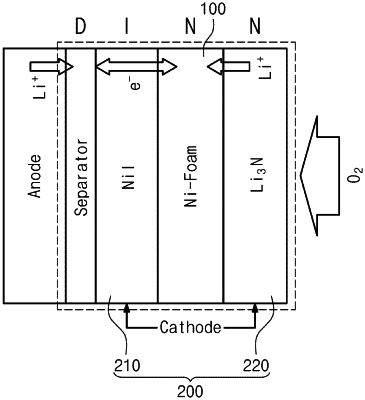| CPC H01M 4/8663 (2013.01) [H01M 4/8605 (2013.01); H01M 4/8673 (2013.01); H01M 4/8828 (2013.01); H01M 4/8885 (2013.01); H01M 12/08 (2013.01)] | 8 Claims |

|
1. An air electrode for a lithium-air secondary battery composed of a lithium anode, a separator, and the air electrode, the air electrode comprising:
an electrode current collector having a shape of a metal foam; and
conductor layers disposed on top of and beneath the electrode current collector to form a multi-layer structure together with the electrode current collector,
wherein the conductor layers include:
a first conductor layer containing an electronically conductive material; and
a second conductor layer containing a lithium ion conductive material,
wherein the first conductor layer and the second conductor layer are respectively disposed at different locations among locations on top of and beneath the electrode current collector,
wherein the multi-layer structure includes:
a first multi-layer structure with the first conductor layer/the electrode current collector/the second conductor layer sequentially stacked; and
a second multi-layer structure with the second conductor layer/the electrode current collector/the first conductor layer sequentially stacked,
wherein the first conductor layer contains the electronically conductive material, a conductive carbon matrix, and a binder in a mass ratio of 4:(3.5-5.5):(0.5-2.5), and
wherein the electronically conductive material includes one electronically conductive material selected from a group consisting of LiI, LiBr, and InI3, and a group consisting of tetrathiafulvalene (TTF) and 2,2,6,6-tetramethyl-1-piperidinyloxy (TEMPO).
|